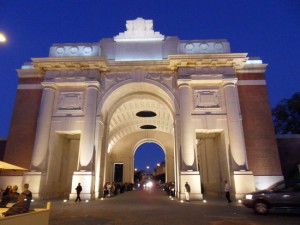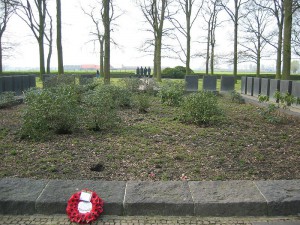Imperial War Graves

Menin Gate, Ieper (Ypres)
Here was the world’s worst wound. And here with pride
‘Their name liveth for evermore’ the Gateway claims.
Was ever an immolation so belied
As these intolerably nameless names?
Well might the Dead who struggled in the slime
Rise and deride this sepulchre of crime.- Siegfried Sassoon on the Menin Gate
I’ve just spent a couple of days wandering through the memorials and cemeteries that the litter the landscape around Ieper (Ypres) in Flanders.
I walked under the Menin Gate. Fifty thousand names arranged by range and by unit list those “whom the fortunes of war denied the known and honoured burial given to their comrades in death”.
Their names tower before me.
Hundreds gather underneath, cameras snapping, as the Last Post is played.
Two school children lay a wreath, the pipes are played, and then we wander away as the words “PRO PATRIA” and “PRO REGE” stare down from above.
At Tyne Cot eleven thousand nine hundred and fifty four marble headstones stand in a careful rows.
You enter from a gate below, the endless white headstones reach up the hillside before you.
At the centre, the original “Cross of Sacrifice” looks down, and above this, and sweeping across the top of the cemetery, stands the “Memorial to the Missing”.
Graves littered this landscape after the various Battles of Ypres.
At aid posts and dressing stations they resembled cemeteries, but across the battle field crosses stood and remains were buried in ones and twos.
These small burials were collected, exhumed, and consolidated to form the endless white crosses of cemeteries like Tyne Cot.
But it is at Langemark that you will understand the meaning of Menin and Tyne Cot.
At the centre of the German cemetery in Langemark is a small garden. Perhaps ten metres by ten metres.
The exhumed remains of twenty four thousand German soldiers were dumped in this mass grave.
The way in which the dead are remembered is not neutral, natural or apolitical.
Unadorned, the piles of the dead are an indictment.
You cannot look upon the mass grave at Langemark and not despise those responsible for the commission of so monstrous a crime.
Menin Gate and Tyne Cot are no mere memorials, they serve a clear and reactionary political purpose in the context of the immediate post war period. These monuments serve to recast the nature of the crime they record.
On the walls of the Menin Gate, the dead are not working class conscripts, callously butchered in the name of a lie. No, they are heroic figures, who have nobly sacrificed for the cause. This monument sanctifies them in the name of King and Country.
With a sweeping layout and grand architecture, death is made glorious. Sad, yes, sacrifice for empire entails sadness, but it’s noble, pure, and glorious to “sacrifice”, “pro rege, pro patria”.
With this slight of hand, the ruling class butchers absolve themselves of guilt. The dead have been conscripted a second time.
And the dead can be wielded against all criticism. Criticize the war, the state, the ruling class, that bastard the King? How dare you spit on the memory of our pure noble sacrificing sons.
In prior wars the dead were seldom remembered. After a battle bodies were quickly dumped in a mass grave, or cremated to avoid the possibility of disease. A dead general or admiral might warrant a statue, but that mass of dead peasants? Who cares?
But in World War I the scale of destruction undermined the legitimacy of the system that caused it, in the eyes of anyone who could comprehend it. As tens of thousands and then hundreds of thousands died, as the French army mutinied and as Russia revolted, the memory of the individual dead suddenly became a state matter rather than an individual matter.
Twenty four thousand German graves could be disinterred and the remains dumped in a pit, but the British ruling class required their dead a second time.

Headstone of Arthur Conway Young, “sacrificed to the fallacy that war can end war”, inscriptions on headstones were chosen by the family. Photo Credit
Update – Further Reading: Were many people upset when they announced they weren’t bringing back the bodies England’s war dead back at the end of WW1?



Riveting piece on the Imperial War Graves in France. Conscripting the dead to fight again. | Kieran’s Review – http://t.co/Ij2R0PjRPM
A brilliant piece. One of the best I’ve seen in years.